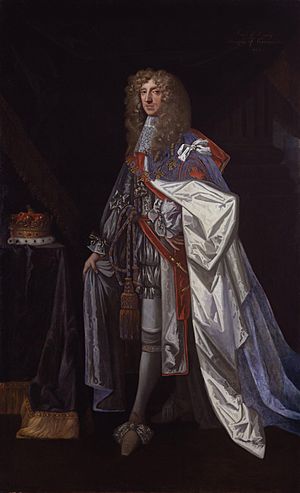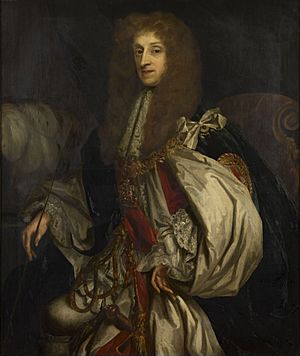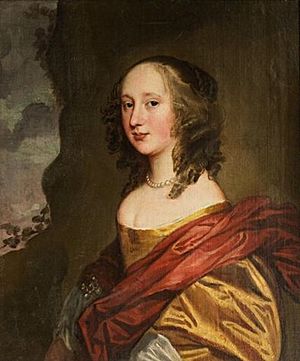Thomas Osborne, 1st Duke of Leeds facts for kids
Quick facts for kids
The Duke of Leeds
|
|
|---|---|
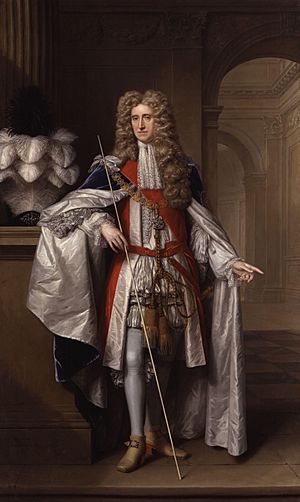 |
|
| Other titles | 1st Viscount Osborne (1673), 1st Viscount Latimer (1673), 1st Earl of Danby (1674), 1st Marquess of Carmarthen (1689) |
| Born | 20 February 1632 |
| Died | 26 July 1712 (aged 80) |
| Father | Sir Edward Osborne, 1st Baronet |
| Mother | Anne Walmesley |
| Treasurer of the Navy | |
| In office 1668–1673 |
|
| Monarch | Charles II |
| Preceded by | The Earl of Anglesey |
| Succeeded by | Edward Seymour |
| Chief Minister of Great Britain Lord High Treasurer |
|
| In office 24 June 1673 – 26 March 1679 |
|
| Monarch | Charles II |
| Preceded by | The Lord Clifford of Chudleigh |
| Succeeded by | The Earl of Essex |
| Lord President of the Council | |
| In office 14 February 1689 – 18 May 1699 |
|
| Monarch | William III and Mary II |
| Preceded by | The Earl of Sunderland |
| Succeeded by | The Earl of Pembroke and Montgomery |
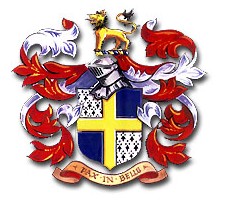
Thomas Osborne, 1st Duke of Leeds (born February 20, 1632 – died July 26, 1712) was an important English politician. He was a member of the Tory party. For about five years in the mid-1670s, he was the main leader in the English government under Charles II of England.
Later, he faced accusations and was held in the Tower of London for five years. This happened until James II of England became king in 1685. In 1688, Thomas Osborne was one of the "Immortal Seven". This group invited William of Orange to become king during the Glorious Revolution. Osborne was again a key figure in England's government in the early 1690s. He passed away in 1712.
Contents
Early Life and Family History
Thomas Osborne was born in 1632. His father was Sir Edward Osborne, a Baronet from Kiveton, Yorkshire. His mother was Anne Walmesley.
Thomas's great-grandfather, also named Sir Edward Osborne, was a Lord Mayor of London. A famous story says that he saved his employer's daughter, Anne, from drowning in the London Bridge river. He later married her, which helped his family become wealthy.
Thomas's father was a strong supporter of the King during the English Civil War. Thomas had an older half-brother, Edward, who died in an accident in 1638. A family story says Thomas survived because he was looking for his cat under a table when the roof of their home collapsed.
When his father died in 1647, Thomas inherited the family lands and title. In 1651, he married Lady Bridget, the daughter of Montagu Bertie, 2nd Earl of Lindsey.
Starting a Public Career (1665–1674)
Thomas Osborne began his public life with help from his neighbor, George Villiers, 2nd Duke of Buckingham. In 1661, he became the High Sheriff of Yorkshire. Then, in 1665, he was elected as a MP for York.
He started to rise in power by joining an effort against the Earl of Clarendon in 1667. In 1668, he became a joint Treasurer of the Navy. Later, he became the sole treasurer. He also took on other important roles in the government.
In 1673, he was given the title Viscount Osborne. He also became a Privy Councillor. In June 1673, he was made Lord High Treasurer, a very important financial role. He also received the titles Baron Osborne of Kiveton and Viscount Latimer. In 1674, King Charles II made him Earl of Danby. He also became a Knight of the Garter in 1677.
Leading the King's Government (1674–1678)
As a leader, Danby wanted to make the King's power stronger. He also strongly supported the official church. He did not like Roman Catholics or Protestants who disagreed with the Church of England. He believed in strict rules against them.
Danby is known for being one of the first to manage Parliament. This meant he worked to get many members of Parliament to support the King's plans. He used rewards and positions to gain support. He believed the King needed to reward those who helped him and punish those who did not.
Dealing with Other Countries
Danby also focused on England's place in the world. He wanted to improve England's trade and power. He was against the influence of both the Roman Catholic Church and France. He believed England should be friends with the Dutch Republic, not France.
In 1674, he ended the war with the Dutch Republic. He then worked to build a friendship with William of Orange, the Dutch leader. In 1677, after long talks, he helped arrange the marriage between William and Mary. This marriage was very important for the future of England, leading to the Glorious Revolution.
Even though Danby worked for England's interests, he also had to follow King Charles II's secret agreements with the King of France. These agreements involved Charles receiving money from France. In 1676, Danby agreed to a treaty where England and France would work together, and Charles would get a large yearly payment.
However, Danby still wanted to help England. He even helped pass a law to raise money for a war against France. He also helped form an alliance with the Dutch Republic. France saw Danby as an enemy because he worked against their interests.
Challenges and Imprisonment (1678–1688)
Danby faced many challenges. Even though his policies often matched what people wanted, he was not very popular. People said he was too focused on his own power and made money from his position. He was also accused of being dishonest.
In 1678, a major event called the "Popish Plot" began. This was a false story about a Catholic plan to kill the King. Danby was accused of hiding information about this plot.
Accusations and Impeachment
Danby had made an enemy of a politician named Ralph Montagu. Montagu worked with the French ambassador to bring Danby down. In December 1678, Montagu read letters in Parliament that showed Danby's involvement in the King's secret dealings with France.
Parliament decided to start an impeachment process against Danby. This is a formal accusation against a public official. He was accused of taking royal powers and misusing money. The King tried to protect Danby by giving him a pardon, but Parliament said the King's pardon could not stop an impeachment.
Danby was forced to leave his job. He was sent to the Tower of London and stayed there for almost five years. During this time, false stories were spread about him, even accusing him of murder. He tried to get a trial, but it was difficult. Finally, in 1684, he was released on bail. He did not take part in public life for the rest of King Charles II's reign.
Return to Power Under William III (1688–1702)
When James II became king, Danby was fully freed. He returned to Parliament as a leader of the moderate Tory party. However, he soon disagreed with King James, especially about James's support for Catholicism.
In 1688, Danby was one of the "Immortal Seven" who invited William of Orange to come to England. This led to the Glorious Revolution, where William and Mary became joint rulers. Danby played a very important role in this change.
In 1689, he was given the title Marquess of Carmarthen. He was also made Lord President of the Council, a high government position. However, he was still not very popular with the Whigs, another political group.
Advisor to the Queen
In 1690, when King William was away in Ireland, Carmarthen became Queen Mary's main advisor. In 1694, he was given the highest title: Duke of Leeds.
However, he faced new accusations. In 1695, he was accused of taking a large sum of money from the British East India Company to help them get a new charter. While he denied taking the money, he admitted that such payments were common in public business at the time. Since there was no clear proof, the case against him ended.
In 1699, he had to leave his government job. He also lost his position as Lord-Lieutenant of Yorkshire.
Later Years and Retirement (1702–1712)
During the reign of Queen Anne, the Duke of Leeds was an old man. He was still very smart and experienced, but he was no longer seen as a leader by any political group.
Even though he was retired, he still took part in politics. He was a strong supporter of the Church of England. In 1705, he supported a motion that the Church of England was in danger. He continued to speak in Parliament, even at the age of 80.
Thomas Osborne, 1st Duke of Leeds, passed away on July 26, 1712, in Easton Neston, Northamptonshire, England. He was buried in the Osborne family chapel at All Hallows Church, Harthill, South Yorkshire.
His titles and lands went to his oldest living son, Peregrine (1659–1729). Peregrine was also a naval officer in the Royal Navy, rising to the rank of vice admiral.
Family
Thomas Osborne and his wife Bridget had ten children:
- Lady Catherine Osborne (1653 – 1702)
- Edward Osborne, Viscount Latimer (c.1655 – January 1689)
- A son who died as a baby
- Lady Anne Osborne (1657–1722)
- Peregrine Osborne, 2nd Duke of Leeds (1659–1729)
- Lady Sophia Osborne (1661 – December 8, 1746)
- Lady Bridget Osborne (1664 – May 9, 1718)
- Lady Martha Osborne (c.1664 – September 11, 1689)
- Francis Osborne (1686 – 1749)
- A daughter who died as a baby
Bridget, Duchess of Leeds, passed away in June 1703.
See also
 In Spanish: Thomas Osborne, conde de Danby para niños
In Spanish: Thomas Osborne, conde de Danby para niños
- List of deserters from James II to William of Orange
- Nathaniel Bladen, was Steward to Danby for almost 30 years from the 1660s to the 1690s.


